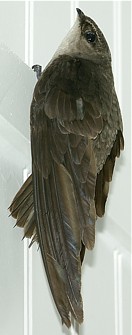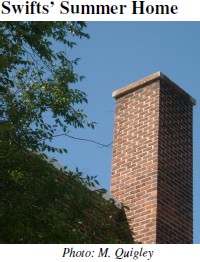
Help Us Make a Swift Recovery
| By Laurel McDonald, Manitoba Chimney Swift Initiative Coordinator. |
Fortunately for the mosquitoes,
the Canadian Chimney Swift population has decreased by about ninety-five
percent in the last forty years. In 2007, The Committee on the
Status of Endangered Wildlife in Canada (COSEWIC) recognized this
trend, and officially designated the Chimney Swift a threatened
species. Although many factors may be contributing to the decline
of the Chimney Swift, it appears most affected by the decrease
in number of traditional masonry chimneys where it nests. The
nest of the Chimney Swift is composed of small twigs, glued together
and to the wall of the chimney with the parents’ sticky
saliva. Roosting adult swifts cling vertically to the rough inner
wall of the chimney. Chimney Swifts pose no threat to personal
property as their nests are too small to cause chimney fires.
Likewise, they migrate to the Amazon Basin in South America after
the nesting season, so are not bothered by winter fireplace use.
Historically, Unfortunately, the era of traditional, masonry chimneys was not long-lived in North America. Since the 1960’s, chimneys have undergone many changes due to new building codes, changing energy sources, and safety concerns. Most chimneys are now either lined with metal, making them too slippery for swifts to cling to or attach their nests, or they are capped off completely. In addition, not all chimneys are equal in the eyes of a swift. Because swifts fly in and out of their homes, the interior diameter of a chimney must be at least twenty-five to thirty centimetres, the wingspan of a swift. Due to their feeding habits, Chimney Swifts are also strongly associated with water, and therefore, the vast majority of nesting chimneys are located within one kilometre of a water body. Indeed, researchers in Québec have discovered that approximately thirty-five percent of adult swifts in that province do not breed, likely due to a lack of suitable chimneys. In 2006 the Manitoba Chimney Swift Initiative (MCSI) was formed to respond to this problem. Since the summer of 2007, many volunteers have donated their time to identify and monitor Chimney Swift nesting and roosting sites throughout Manitoba. The resulting data has increased MCSI’s knowledge of the Manitoba population, and enabled it to choose appropriate sites to build five artificial nesting towers, one each in Starbuck, St. Adolphe, and Portage la Prairie, and two in Winnipeg in the summer of 2008. The Manitoba Chimney Swift Initiative hopes that the Chimney Swifts will appreciate these new homes, and that, with the aid of volunteers, we will be able to contribute to reversing the decline of this beautiful bird.
Nature Manitoba Chimney Swift Initiative Frank Machovec via email or at 204-798-6275. |
|
NatureNorth.com would like to thank Laurel McDonald and the Manitoba Chimney Swift Initiative for providing us with this information to publish. Thanks also to Mike Quigley, Christian Artuso and others for the images we lifted to decorate this article.
| You can help NatureNorth produce more great articles with a secure donation through PayPal. Our Google Adsense ads pay our server costs, but that's about it. To learn more follow this link: Support NatureNorth. Thank-you! | |
Return to: Summer Issue | NatureNorth Front page

 Chimneys
in your neighbourhood may be providing essential habitat
for a threatened species of bird, the Chimney Swift (Chaetura
pelagica). A small, swallow-like bird with long, narrow wings
and a very short tail, the Chimney Swift is often described as
"a cigar with wings." One of our most aerial birds,
they leave our skies only to tend their nests and roost for the
night. Not only do they feed on the wing, they also drink by skimming
water with their beaks, bathe by slapping their breasts against
surface water, and collect nesting material by breaking off dry
twigs with their feet, all without ever touching ground. While
their legs and feet are strong, and equipped with four long, sharp
claws for gripping vertical surfaces, they are not able to stand
or perch in the manner of most other birds. Swifts feed exclusively
on insects caught in flight. Indeed, each swift can eat over one
thousand insects per day, including mosquitoes.
Chimneys
in your neighbourhood may be providing essential habitat
for a threatened species of bird, the Chimney Swift (Chaetura
pelagica). A small, swallow-like bird with long, narrow wings
and a very short tail, the Chimney Swift is often described as
"a cigar with wings." One of our most aerial birds,
they leave our skies only to tend their nests and roost for the
night. Not only do they feed on the wing, they also drink by skimming
water with their beaks, bathe by slapping their breasts against
surface water, and collect nesting material by breaking off dry
twigs with their feet, all without ever touching ground. While
their legs and feet are strong, and equipped with four long, sharp
claws for gripping vertical surfaces, they are not able to stand
or perch in the manner of most other birds. Swifts feed exclusively
on insects caught in flight. Indeed, each swift can eat over one
thousand insects per day, including mosquitoes.  Chimney
Swifts used large, hollow trees for nesting and roosting, and
were associated mainly with old-growth forests. The arrival of
European settlers spelled the end of most of these forests; however,
Chimney Swifts proved themselves highly adaptable by recognizing
the chimneys of colonial towns and cities as an alternative habitat.
Chimney
Swifts used large, hollow trees for nesting and roosting, and
were associated mainly with old-growth forests. The arrival of
European settlers spelled the end of most of these forests; however,
Chimney Swifts proved themselves highly adaptable by recognizing
the chimneys of colonial towns and cities as an alternative habitat.  You
can help us help the Chimney Swift by identifying and monitoring
nesting and roosting sites in your area. For more information,
please visit our website at:
You
can help us help the Chimney Swift by identifying and monitoring
nesting and roosting sites in your area. For more information,
please visit our website at: 

